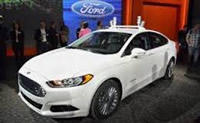Ford, U-M Accelerate Autonomous Vehicle Research with Ford Researchers In-House at New Robotics Lab on U-M Campus
 Ford and the University of Michigan today announce they are teaming up to accelerate autonomous vehicle research and development with a first-ever arrangement that embeds Ford researchers and engineers into a new state-of-the-art robotics laboratory on U-M's Ann Arbor campus.
Ford and the University of Michigan today announce they are teaming up to accelerate autonomous vehicle research and development with a first-ever arrangement that embeds Ford researchers and engineers into a new state-of-the-art robotics laboratory on U-M's Ann Arbor campus.
While the new robotics laboratory opens in 2020, by the end of this year Ford will move a dozen researchers into the North Campus Research Complex (NCRC).
The announcement is the latest in a series of actions by Ford as it moves toward having fully autonomous SAE-defined level 4-capable vehicles available for high-volume commercial use in 2021. Autonomous vehicles are part of Ford's expansion to be an auto and a mobility company. Full Press Release:
Featured Product

